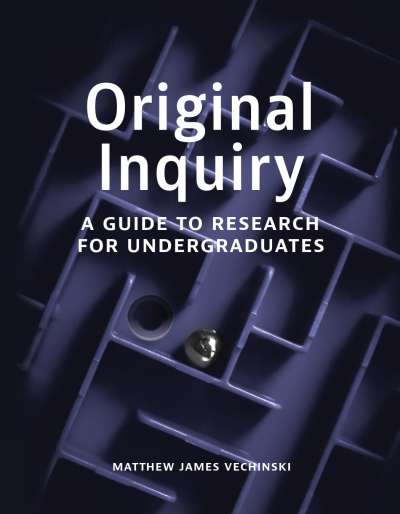Research Now: Contemporary Writing in the Disciplines is designed to help students make the transition into academic discourse. It gathers exciting current scholarship from across the disciplines in a concise collection of research-oriented academic prose. Most of the readings first appeared in academic journals, but there are other forms of research writing as well, including a book chapter by a senior scholar and a proposal by a graduate student. The selections were written by researchers from around the world working in the sciences, social sciences, and humanities.
The introduction gives a helpful overview of academic genres, research methods, and the path to academic publication. Each reading includes questions designed to provoke student engagement and discussion; a glossary and short guide to reading statistics are also included.
Comments
“All incoming university students should read this book. (Truth be told, all university instructors should, too!) It provides an eye-opening introduction to academic writing and, in the process, explains the disciplinary cultures that shape how we look, think, and write across the university campus. With just the right mixture of accessible theory, highly readable examples, and post-reading questions, Daniel Burgoyne and Richard Gooding introduce readers to the often-mysterious practices and dispositions of research writing. The result is sure to be twofold: students will more quickly join their disciplinary conversations, and they will develop an appreciation for the myriad ways in which knowledge is made through research writing.” — Anthony Paré, University of British Columbia
Introduction
ONE POPULAR CULTURE AND VISUAL MEDIA
- Introduction
- A “Educating The Simpsons: Teaching Queer Representations in Contemporary Visual Media,” Gilad Padva
- B “Cripples, Bastards and Broken Things: Disability in Game of Thrones,” Katie M. Ellis
- C “Images of Women in General Interest and Fashion Magazine Advertisements from 1955 to 2002,” Katharina Lindner
- D “Avenger, Mutant, or Allah: A Short Evolution of the Depiction of Muslims in Marvel Comics,” Nicholaus Pumphrey
- E “Frozen Jet Set: Refrigerators, Media Technology, and Postwar Transportation,” Paul Gansky
TWO SOCIAL MEDIA AND LI FE ONLINE
- Introduction
- A “Fantasy Facebook: An Exploration of Students’ Cultural Sources,” Amber E. Ward
- B “Fraping, Social Norms and Online Representations of Self,” Wendy Moncur, Kathryn M. Orzech, and Fergus G. Neville
- C “The Role of Narcissism in Self-Promotion on Instagram,” Jang Ho Moon, Eunji Lee, Jung-Ah Lee, Tae Rang Choi, and Yongjun Sung
- D “Exploring Rape Culture in Social Media Forums,” Kristen L. Zaleski, Kristin K. Gundersen, Jessica Baes, Ely Estupinian, and Alyssa Vergara
- E “Blogging a Research Paper? Researched Blogs as New Models of Public Discourse,” Lisa A. Costello
THREE ENVIRONMENT AND SOCIETY
- Introduction
- A “Continent-wide Analysis of How Urbanization Affects Bird-Window Collision Mortality in North America,” Stephen B. Hager et al.
- B “Green Screen or Smokescreen? Hollywood’s Messages about Nature and the Environment,” Ellen Elizabeth Moore
- C “The Enrollment of Nature in Tourist Information: Framing Urban Nature as ‘the Other,’” Ylva Uggla and Ulrika Olausson
- D “Green Infrastructure as Life Support: Urban Nature and Climate Change,” Sheryn D. Pitman, Christopher B. Daniels, and Martin E. Ely
- E “Environmental Science and Public Policy in Executive Government: Insights from Australia and Canada,” Briony M. Lalor and Gordon M. Hickey
FOUR DEMOCRACY AND THE GLOBAL CITIZEN
- Introduction
- A “The Networked Young Citizen: Social Media, Political Participation and Civic Engagement,” Brian D. Loader, Ariadne Vromen, and Michael A. Xenos
- B “Democracy is Democracy is Democracy? Changes in Evaluations of International Institutions in Academic Textbooks, 1970–2010,” Klaus Dingwerth, Ina Lehmann, Ellen Reichel, and Tobias Weise
- C “Social Media, Public Discourse, and Governance,” Maria Consuelo C. Ortuoste
- D “Politics and Patriotism in Education,” Joel Westheimer
- E “Using Social Media Dialogically: Public Relations Role in Reviving Democracy,” Michael L. Kent
FIVE SCIENCE AND PUBLIC DISCOURSE
- Introduction
- A “Our Year on Twitter: Science in #SocialMedia,” Louise J. McHeyzer- Williams and Michael G. McHeyzer-Williams
- B “How to Be Cautious but Open to Learning: Time to Update Biotechnology and GMO Legislation,” Sven Ove Hansson
- C “Vaccination, Fear, and Historical Relevance,” Rob Boddice
- D “Olfactory Identification Decline as a Preclinical Biomarker for Alzheimer’s Disease,” Jamie Knight
- E “Foreshadowing Alzheimer’s: Variability and Coupling of Olfaction and Cognition,” Jamie E. Knight and Andrea M. Piccinin, University of Victoria, BC, Canada
- F “Olfactory Impairment in Presymptomatic Alzheimer’s Disease,” Robert S. Wilson, Steven E. Arnold, Julie A. Schneider, Patricia A. Boyle, Aron S. Buchman, and David A. Bennett
SIX HUMAN AND POSTHUMAN
- Introduction
- A “The Cyborg Revolution,” Kevin Warwick
- B “In Defence of Posthuman Dignity,” Nick Bostrom
- C “Posthuman,” Nicholas Gane
- D “The Final Frontier? Religion and Posthumanism in Film and Television,” Elaine Graham
A Note on Statistics by James Johnson
Glossary
Permissions Acknowledgements
Daniel Burgoyne is Professor of English at Vancouver Island University. Richard Gooding is an Instructor in the Department of English Language and Literatures at the University of British Columbia.











